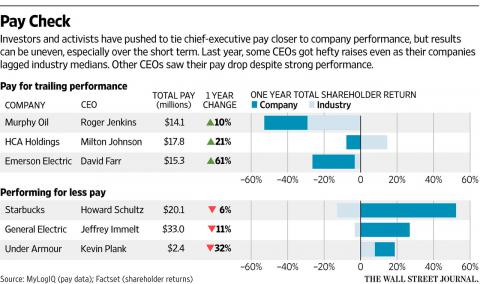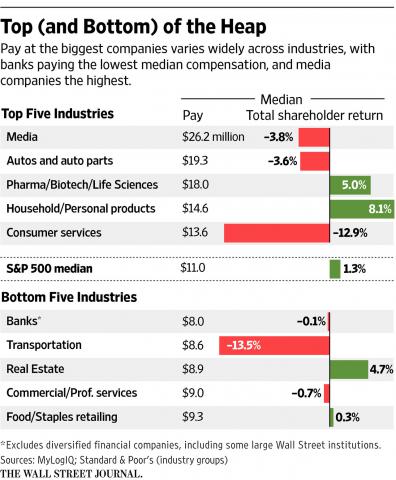You are here
CEO Pay Shrinks 4.6% but Offers Weak Reflection of Performance
None of last year’s 10 highest-paid chiefs among the S&P 500 ran one of the best-performing companies
Part of The Wall Street Journal's annual CEO pay survey. See also the accompanying interactive graphic allowing readers to explore the data.
Median pay for chief executives of the biggest U.S. companies slipped 4.6% last year, but the link between annual compensation and shareholder returns remained weak.
A Wall Street Journal analysis of S&P 500 companies found that none of the year’s 10 highest-paid CEOs ran one of the 10 best-performing companies. Only three of those executives led a company ranked among the top 10% in total shareholder return.
More broadly, the best-performing tier of CEOs in the analysis received the lowest median compensation for the year, at $10.2 million.
There was little correlation between executive pay and annual corporate performance, even within the same industry. In six industries, including utilities and diversified financial services, the year’s top-paid CEOs ran the worst-performing companies. In seven industries, including pharmaceuticals and retailing, the lowest-paid CEOs ran the best performers.
In the longer term, pay and performance appear to be more closely aligned. Over the past five years, shareholder return for most S&P 500 companies has exceeded the growth in their CEOs’ pay, according to an analysis by ISS Corporate Solutions.
“Most companies do a pretty good job” of linking pay and performance, says John Roe, head of advisory services at the Institutional Shareholder Services unit. “Is there room to grow? Yes.”
Various factors can lead to a divergence between CEO pay and annual corporate performance, compensation consultants say. Tough times prompt some companies to reward executives for strategic or operational overhauls. Others base pay on longer-term benchmarks that might be little affected by a single year of underperformance.
Overall, median compensation for S&P 500 CEOs fell to about $11 million in 2015 from about $11.5 million in 2014, according to the Journal’s analysis of data from MyLogIQ. Last year’s median shareholder return, including dividends, was 1.3% for companies in the analysis, compared with 18% the year before.
The top paid chief in the Journal’s analysis was Dara Khosrowshahi of internet travel company Expedia Inc. EXPE -0.66% The 47-year-old executive received compensation of $94.6 million last year, including $90.8 million in stock options that vest over the next four years. That marked a sharp increase from the $9.6 million he made in 2014, and was nine times what Apple Inc. AAPL -0.17% paid Timothy Cook last year.
Expedia, which is controlled by billionaire Barry Diller, said the award is designed to keep its leader in the job over the long term. “We have no intention of providing additional equity until 2020,” said Expedia spokeswoman Sarah Gavin.
Mr. Khosrowshahi was followed by two chief executives in media mogul Sumner Redstone’s empire: Leslie Moonves of CBS Corp.CBS -0.05% , at $56.8 million, and Philippe Dauman of Viacom Inc.,VIAB 0.60% at $54.2 million. A power struggle at Viacom could imperil Mr. Dauman’s position.
Both CBS and Viacom lagged behind the median return for S&P 500 media companies, which was -3.8% last year. Shareholder return was -13.8% for CBS, and -42% for Viacom.
In its proxy, Viacom says that about $17 million of Mr. Dauman’s pay is a stock-based bonus that vests over three years, awarded with the nearly four-year renewal of his employment agreement in January 2015; it can become more or less valuable with company performance. A CBS spokesman declined to comment.
Rounding out the top five were Mark Hurd and Safra Catz, the co-CEOs at software giant Oracle Corp. ORCL 0.13% , who received $53.2 million apiece last year. Their pay included one-time equity awards of $9 million each, reflecting their expanded duties as co-CEOs, Oracle said in its proxy. In November, in a nonbinding vote, investors rejected the company’s pay practices for the fourth straight year. An Oracle spokeswoman declined to comment.
Media CEOs often rank among the highest paid, and in 2015 accounted for four of the top 10 spots. Median pay for media CEOs was the highest of any industry group, at $26.2 million last year, more than double the S&P 500 median.
Auto and auto-parts CEOs had the second-highest median pay, at $19.3 million, followed by pharmaceutical and biotech chiefs, at $18 million. Banks—a group that excludes some of the biggest diversified financial companies—ranked last, at $8 million.
The Journal analyzed CEO compensation and performance data for S&P 500 companies that disclosed pay details between July 1, 2015, and May 31.
Some high-profile chiefs were omitted, along with others at smaller companies who make significant sums. For example, Google Inc.’s Sundar Pichai received $100.5 million in 2015, but he runs a unit of S&P 500 member Alphabet Inc., GOOGL 0.14% which paid CEO Larry Page $1 last year.
Restricted shares made up nearly half of last year’s CEO pay, and equity of any kind made up 63% of pay, compared with an average of about 57% over the past five years.
“It aligns directly with the shareholders, which is in general a good thing,” said Gregg Passin, head of the North American executive-pay practice at consulting firm Mercer. Still, “there’s probably an upper limit at some point, somewhere a little bit north of where we are.”
WSJ PROMOTION
Join reporters Joann S. Lublin and Theo Francis at a WSJ+ live event in New York on June 7. They’ll discuss trends in pay practices, how CEO pay ties into stock performance and how to dissect SEC filings to find the data. Learn more at WSJplus.com/ceo-pay
The total pay of some big-name bosses, including General Electric Co.’sGE -0.15% Jeff Immelt and Starbucks Corp.’sSBUX 0.64% Howard Schultz, declined last year, even though their companies outperformed industry peers.
Others received big raises even as shareholders suffered. Pitney Bowes Inc. PBI -0.40% CEO Marc Lautenbach’s compensation rose 55% to $10.8 million. The mailing-services company had a shareholder return of -12.2%, trailing a median shareholder return of -0.7% for its industry.
The jump came in part because Mr. Lautenbach received the payout from a three-year cash incentive program. He was paid less than targeted for the portion of his 2015 compensation tied to the year’s performance, and most of his pay depends on three-year measures, said spokesman Bill Hughes. “Our performance over the last three years was strong.”
Continuing a recent pattern, the S&P 500’s roughly two dozen female CEOs made more than their male counterparts, with median pay of $14.8 million. After Ms. Catz, the highest-paid women were YahooInc.’s YHOO 0.14% Marissa Mayer, at $36 million, and General Motors Co.’s GM 1.44% Mary Barra, at $29 million. Yahoo’s proxy notes that some of Ms. Mayer’s 2015 equity awards failed to vest because of the company’s poor performance.
Ms. Barra’s pay jumped 77% largely because of a one-time option grant valued at $11.2 million. A spokesman said Ms. Barra’s package aligns her interests with those of shareholders.
See how the Journal analyzed CEO compensation for this article.
Write to Theo Francis at theo.francis@wsj.com and Joann S. Lublin at joann.lublin@wsj.com
Appeared in the June 3, 2016, print edition as 'Divide Persists Between Pay, Performance.'

